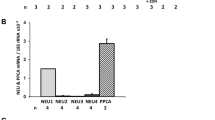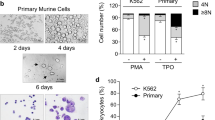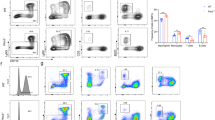Abstract
Activation of phospholipase D (PLD) occurs in response to various stimuli and results from the activity of two isozymes, hPLD1 and hPLD2. PLD activity appears to be involved in several myeloid cell processes during their development and activation, including proliferation of myeloblasts in the bone marrow and secretion, phagocytosis and NADPH oxidase activation, essential functions of differentiated neutrophils. The present work studies PLD characteristics, activity and both isozyme expression during maturation and differentiation of myeloid cells by using three different systems: leukemic myeloblasts at different stages of maturation, terminally differentiated neutrophils ex vivo and four human myeloid cell lines, NB4, HL-60, PLB 985 and U937, induced to differentiate with all-trans retinoic acid (ATRA), a cyclic adenosine monophosphate (cAMP) analogue or both agents together. HL-60, a bipotential cell line has also been differentiated along the granulocytic pathway with DMSO and the monocytic pathway with 1,25-dihydroxy vitamin D3. In all these systems, PLD activity increases with maturation and differentiation whatever the inducer used and the granulocytic or monocytic pathways. Increase in basal activity which reflects the expression during development of both hPLD1 and hPLD2 appears to be mainly related to the former isozyme expression. Association of PLD characteristic changes with maturation and differentiation was also confirmed using two NB4 clones resistant to these processes. Comparison between PLD characteristics in myeloblasts during maturation and differentiation ex vivo and in vitro in the different cell lines demonstrated that NB4 induced to differentiate with ATRA represents the best model for further studies on the specific roles of each PLD isoform in various functions of differentiated myeloid cells.
This is a preview of subscription content, access via your institution
Access options
Subscribe to this journal
Receive 12 print issues and online access
$259.00 per year
only $21.58 per issue
Buy this article
- Purchase on Springer Link
- Instant access to full article PDF
Prices may be subject to local taxes which are calculated during checkout







Similar content being viewed by others
References
Ali H, Haribabu B, Richardson RM, Snyderman R . Mechanisms of inflammation and leukocyte activation Adv Rheumatol 1997 81: 1–28
Castaigne S, Chomienne C, Daniel MT, Ballerini P, Berger R Fenaux P, Degos L . All-trans retinoic acid as a differentiation therapy for acute promyelocytic leukemia: I. clinical results Blood 1990 76: 1704–1709
Fenaux P, Castaigne S, Dombret H, Archimbaud, E, Duarte M, Morel P, Lamy T, Tilly H, Guerci A, Maloisel F, Bordessoule D, Sadoun A, Tiberghein P, Fegueux N, Daniel M-T, Chomienne C, Degos L . All-trans retinoic acid followed by intensive chemotherapy gives a high complete remission rate and may prolong remission in newly diagnosed acute promyelocytic leukemia: a pilot study on 26 cases Blood 1992 80: 2176–2181
Liscovitch M, Czarny M, Fiucci G, Tang X . Phospholipase D: molecular and cell biology of a novel gene family Biochem J 2000 345: 401–415
English D, Cui Y, Siddiqui RA . Messenger functions of phosphatidic acid Chem Phys Lipids 1996 80: 117–132
Hammond SM, Altshuller YM, Sung T-C, Rudge SA, Rose K, Engebrecht J, Morris AJ, Frohman MA . Human ADP-ribosylation activated phosphatidylcholine-specific phospholipase D defines a new and highly conserved gene family J Biol Chem 1995 270: 29640–29643
Lopez I, Arnold RS, Lambeth JD . Cloning and initial characterization of a human phospholipase D2 (hPLD2) J Biol Chem 1998 273: 12846–12852
Colley WC, Altshuller YM, Sue-Ling CK, Copeland NG, Gilbert DJ, Jenkins NA, Branch KD, Tsirka SE, Bollag RJ, Bollag WB, Frohman MA . Cloning and expression analysis of murine phospholipase D1 Biochem J 1997 326: 745–753
Park S-K, Provost JJ, Bae CD, Ho W-T, Exton JH . Cloning and characterization of phospholipase D from rat brain J Biol Chem 1997 272: 29263–29271
Dalton WT, Aheearn M, McCredie K, Freidreich EJ, Stass SA, Trujillo JM . HL60 cell line was derived from a patient with FAB-M2 and not FAB-M3 Blood 1988 71: 242–247
Lanotte M, Martin-Thouvenin V, Najman S, Ballerini P, Valensi F, Berger R . NB4, a maturation inducible cell line with t(15/17) marker isolated from a human acute promyelocytic leukemia (M3) Blood 1990 77: 1080–1086
Breitman TR, Selonick SE, Collins SJ . Induction of differentiation of the human promelocytic leukemia cell line (HL-60) by retinoic acid Proc Natl Acad Sci USA 1980 77: 2936–2940
Chaplinski TJ, Niedel JE . Cyclic nucleotide-induced maturation of human promyelocytic leukemia cells J Clin Invest 1982 70: 953–964
Geny B, Cockcroft S . Synergistic activation of phospholipase D by protein kinase C- and G-protein-mediated pathways in streptolysin O-permeabilized HL-60 cells Biochem J 1992 284: 531–538
Marcil J, Harbour D, Naccache PH, Bourgoin S . Human phospholipase D1 can be tyrosine phosphorylated in HL-60 granulocytes J Biol Chem 1997 272: 20660–20664
Ruchaud S, Duprez E, Gendron MC, Houge G, Genieser HG, Jastorff B, Doskeland SO, Lanotte M . Two distinctly regulated events, priming and triggering, during retinoic-induced maturation and resistance of NB4 promyelocytic leukemia cell line Proc Natl Acad Sci USA 1994 91: 8428–8432
Duprez E, Benoit G, Flexor M, Lillehaug JR, Lanotte M . A mutated PML/RARA found in the retinoid maturation resistant NB4 subclone NB4-R2, blocks RARA and wild-type PML/RARA transcriptional activities Leukemia 2000 14: 255–261
Warrell RPJ, Frankel SR, Miller WH Jr, Scheinberg DA, Itri LM, Hittelman WN, Vyas R, Andreeff M, Tafuri A, Jakubowski A, Gabrilove J, Gordon M, Dmitrovsky, E . Differentiation therapy of acute promyelocytic leukemia with tretinoin (all-trans retinoic acid) New Engl J Med 1991 324: 1385–1393
Huang ME, Ye YC, Chen SR, Chai JR, Lu JX, Zhoa L, Gu LJ, Wang ZY . Use of all-trans retinoic acid in the treatment of acute promyelocytic leukemia Blood 1988 72: 567–572
Nakashima S, Ohguchi K, Frohman MA, Nozawa Y . Increased mRNA expression of phospholipase D (PLD) isozymes during granulocytic differentiation of HL60 cells Biochim Biophys Acta 1998 1389: 173–177
Zhao D, Berse B, Holler T, Cermak JM, Blusztajn JK . Developmental changes in phospholipase D activity and mRNA levels in rat brain Dev Brain Res 1998 109: 121–127
Griner RD, Quin F, Jung E, Sue-Ling CK, Crawford KB, Mann-Blakeney R, Bollag RJ, Bollinger Bollag W . 1,25-dihydroxyvitamin D3 induces phospholipase D-1 expression in primary mouse epidermal keratinocytes J Biol Chem 1999 274: 4663–4670
Hayakawa K, Nakashima S, Ito Y, Mizuta K, Miyata H, Nozawa Y . Increased expression of phospholipase D1 mRNA during cAMP- or NGF-induced differentition in PC12 cells Neurosci Lett 1999 265: 127–130
Yoshimura S-I, Nakashima S, Ohguchi K, Sakai H, Shinoda J, Sakai N, Nozawa Y . Differential mRNA expression of phospholipase D (PLD) isozymes during cAMP-induced differentiation in C6 glioma cells Biochem Biophys Res Commun 1996 225: 494–499
Min DS, Shin KS, Kim E-G, Kim SR, Yoon SH, Kim M-S, Jo Y-H . Down-regulation of phospholipase D during differentiation of mouse F9 teratocarcinoma cells FEBS Lett 1999 454: 197–200
Moritz A, De Graan PNE, Gispen WH, Wirtz KWA . Phosphatidic acid is a specific activator of phosphatidylinositol-4-phosphate kinase J Biol Chem 1992 267: 7207–7210
Jenkins GH, Fisette PL, Anderson RA . Type I phosphatidylinositol 4-phosphate 5 kinase isoforms are specifically stimulated by phosphatidic acid J Biol Chem 1994 269: 11547–11554
Liscovitch M, Chalifa V, Pertile P, Chen C-S, Cantley LC . Novel function of phosphatidylinositol 4,5-bisphosphate as a cofactor for brain membrane phospholipase D J Biol Chem 1994 269: 21403–21406
Tool ATJ, Blom M, Roos D, Verhoeven AJ . Phospholipase D-derived phosphatidic acid is involved in the activation of the CD11b/CD18 integrin in human eosinophils Biochem J 1999 340: 95–101
Erickson RW, Langel-Peveri P, Traynor-Kaplan AE, Heyworth PG, Curnutte JT . Activation of human neutrophil NADPH oxidase by phosphatidic acid or diacylglycerol in a cell-free system J Biol Chem 1999 274: 22243–22250
Burke JR, Davern LB, Gregor KR, Owczarczak LM . Differentiation of U937 cells enables a phospholipase D-dependent pathway of cytosolic phospholipase A2 activation Biochem Biophys Res Commun 1999 260: 232–239
Geny B, Stutchfield J, Cockcroft . S. Phorbol ester inhibits polyphosphoinositide phosphodiesterase activity stimulated by either Ca2+, fluoride or GTP analogue in HL-60 membranes and in permeabilised HL-60 cells Cell Signal 1989 1: 165–172
Geny B, Cost H, Barreau P, Basset M, Le Peuch C, Abita J-P, Cockcroft S . The differentiating agent, retinoic acid, causes an early inhibition of inositol lipid-specific phospholipase C activity in HL-60 cells Cell Signal 1991 3: 11–23
Grégoire C, Welch H, Astarie-Dequeker C, Maridonneau-Parini I . Expression of azurophil and specific granule proteins during differenciation of NBA cells in neutrophils J Cell Physiol 1998 175: 203–210
Acknowledgements
This work was supported by Association de Recherche sur le Cancer (ARC) Grant No. 9452. MEM was funded by a fellowship la Fondation pour la Recherche Médicale (FRM) and VM is a fellow from l'Association de Recherche sur la Polyarthrite (ARP). We thank Michel Lanotte for providing NB4 cells and resistant clones, Michael Frohman and David Lambeth for providing hPLD1 and hPLD2 cDNA, respectively, Sylvain Bourgoin for the gift of specific antibodies to PLD1 and PLD2, Muriel Gaudry and Axel Perianin for their help in setting the technique for superoxide ion measurement, Sebastien Bergeot for some technical assistance, Babette Weksler and Jean-Paul Mira for reading the manuscript and stimulating discussions.
Author information
Authors and Affiliations
Rights and permissions
About this article
Cite this article
Marjou, M., Montalescot, V., Buzyn, A. et al. Modifications in phospholipase D activity and isoform expression occur upon maturation and differentiation in vivo and in vitro in human myeloid cells. Leukemia 14, 2118–2127 (2000). https://doi.org/10.1038/sj.leu.2401958
Received:
Accepted:
Published:
Issue Date:
DOI: https://doi.org/10.1038/sj.leu.2401958
Keywords
This article is cited by
-
Cell-Specific mRNA Alterations in Na+, K+-ATPase α and β Isoforms and FXYD in Mice Treated Chronically with Carbamazepine, an Anti-Bipolar Drug
Neurochemical Research (2013)
-
Comparison between drug-induced and K+-induced changes in molar acid extrusion fluxes (JH +) and in energy consumption rates in astrocytes
Neurochemical Research (2013)
-
Expression of Nucleoside Transporter in Freshly Isolated Neurons and Astrocytes from Mouse Brain
Neurochemical Research (2013)
-
Cell Type-Specific Gene Expression and Editing Responses to Chronic Fluoxetine Treatment in the In Vivo Mouse Brain and Their Relevance for Stress-Induced Anhedonia
Neurochemical Research (2012)
-
Chronic treatment of astrocytes with therapeutically relevant fluoxetine concentrations enhances cPLA2 expression secondary to 5-HT2B-induced, transactivation-mediated ERK1/2 phosphorylation
Psychopharmacology (2009)



